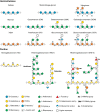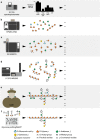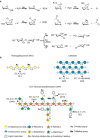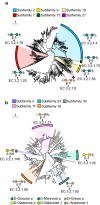Combined whole cell wall analysis and streamlined in silico carbohydrate-active enzyme discovery to improve biocatalytic conversion of agricultural crop residues
- PMID: 33422151
- PMCID: PMC7797155
- DOI: 10.1186/s13068-020-01869-8
Combined whole cell wall analysis and streamlined in silico carbohydrate-active enzyme discovery to improve biocatalytic conversion of agricultural crop residues
Erratum in
-
Correction to: Combined whole cell wall analysis and streamlined in silico carbohydrate‑active enzyme discovery to improve biocatalytic conversion of agricultural crop residues.Biotechnol Biofuels. 2021 Feb 8;14(1):40. doi: 10.1186/s13068-021-01888-z. Biotechnol Biofuels. 2021. PMID: 33557907 Free PMC article. No abstract available.
Abstract
The production of biofuels as an efficient source of renewable energy has received considerable attention due to increasing energy demands and regulatory incentives to reduce greenhouse gas emissions. Second-generation biofuel feedstocks, including agricultural crop residues generated on-farm during annual harvests, are abundant, inexpensive, and sustainable. Unlike first-generation feedstocks, which are enriched in easily fermentable carbohydrates, crop residue cell walls are highly resistant to saccharification, fermentation, and valorization. Crop residues contain recalcitrant polysaccharides, including cellulose, hemicelluloses, pectins, and lignin and lignin-carbohydrate complexes. In addition, their cell walls can vary in linkage structure and monosaccharide composition between plant sources. Characterization of total cell wall structure, including high-resolution analyses of saccharide composition, linkage, and complex structures using chromatography-based methods, nuclear magnetic resonance, -omics, and antibody glycome profiling, provides critical insight into the fine chemistry of feedstock cell walls. Furthermore, improving both the catalytic potential of microbial communities that populate biodigester reactors and the efficiency of pre-treatments used in bioethanol production may improve bioconversion rates and yields. Toward this end, knowledge and characterization of carbohydrate-active enzymes (CAZymes) involved in dynamic biomass deconstruction is pivotal. Here we overview the use of common "-omics"-based methods for the study of lignocellulose-metabolizing communities and microorganisms, as well as methods for annotation and discovery of CAZymes, and accurate prediction of CAZyme function. Emerging approaches for analysis of large datasets, including metagenome-assembled genomes, are also discussed. Using complementary glycomic and meta-omic methods to characterize agricultural residues and the microbial communities that digest them provides promising streams of research to maximize value and energy extraction from crop waste streams.
Keywords: Agriculture; Biomass conversion; Carbohydrate-active enzyme; Crop residues; Functional genomics; Glycosidic linkage analysis; Phylogeny; Plant cell wall.
Conflict of interest statement
The authors declare that they have no competing interests.
Figures





Similar articles
-
Emerging Technologies for the Production of Renewable Liquid Transport Fuels from Biomass Sources Enriched in Plant Cell Walls.Front Plant Sci. 2016 Dec 8;7:1854. doi: 10.3389/fpls.2016.01854. eCollection 2016. Front Plant Sci. 2016. PMID: 28018390 Free PMC article. Review.
-
Engineering grass biomass for sustainable and enhanced bioethanol production.Planta. 2019 Aug;250(2):395-412. doi: 10.1007/s00425-019-03218-y. Epub 2019 Jun 24. Planta. 2019. PMID: 31236698 Review.
-
Multi-omic Directed Discovery of Cellulosomes, Polysaccharide Utilization Loci, and Lignocellulases from an Enriched Rumen Anaerobic Consortium.Appl Environ Microbiol. 2020 Sep 1;86(18):e00199-20. doi: 10.1128/AEM.00199-20. Print 2020 Sep 1. Appl Environ Microbiol. 2020. PMID: 32680862 Free PMC article.
-
Engineering Ligninolytic Consortium for Bioconversion of Lignocelluloses to Ethanol and Chemicals.Protein Pept Lett. 2018;25(2):108-119. doi: 10.2174/0929866525666180122105835. Protein Pept Lett. 2018. PMID: 29359652 Review.
-
Genome-Wide Association Study for Major Biofuel Traits in Sorghum Using Minicore Collection.Protein Pept Lett. 2021;28(8):909-928. doi: 10.2174/0929866528666210215141243. Protein Pept Lett. 2021. PMID: 33588716
Cited by
-
Correction to: Combined whole cell wall analysis and streamlined in silico carbohydrate‑active enzyme discovery to improve biocatalytic conversion of agricultural crop residues.Biotechnol Biofuels. 2021 Feb 8;14(1):40. doi: 10.1186/s13068-021-01888-z. Biotechnol Biofuels. 2021. PMID: 33557907 Free PMC article. No abstract available.
-
Comprehensive Leaf Cell Wall Analysis Using Carbohydrate Microarrays Reveals Polysaccharide-Level Variation between Vitis Species with Differing Resistance to Downy Mildew.Polymers (Basel). 2021 Apr 23;13(9):1379. doi: 10.3390/polym13091379. Polymers (Basel). 2021. PMID: 33922615 Free PMC article.
-
Methylation-GC-MS/FID-Based Glycosidic Linkage Analysis of Unfractionated Polysaccharides in Red Seaweeds.Mar Drugs. 2024 Apr 24;22(5):192. doi: 10.3390/md22050192. Mar Drugs. 2024. PMID: 38786583 Free PMC article.
-
Storming the barricades of rhamnogalacturonan-II synthesis and function.Plant Cell. 2025 Jun 4;37(6):koaf088. doi: 10.1093/plcell/koaf088. Plant Cell. 2025. PMID: 40237333 Free PMC article. Review.
-
Approaches to Investigate Selective Dietary Polysaccharide Utilization by Human Gut Microbiota at a Functional Level.Front Microbiol. 2021 Feb 19;12:632684. doi: 10.3389/fmicb.2021.632684. eCollection 2021. Front Microbiol. 2021. PMID: 33679661 Free PMC article. Review.
References
-
- Callegari A, Bolognesi S, Cecconet D, Capodaglio AG. Production technologies, current role, and future prospects of biofuels feedstocks: a state-of-the-art review. Crit Rev Environ Sci Technol. 2020;50(4):384–436. doi: 10.1080/10643389.2019.1629801. - DOI
-
- Campanaro S, Treu L, Kougias PG, De Francisci D, Valle G, Angelidaki I. Metagenomic analysis and functional characterization of the biogas microbiome using high throughput shotgun sequencing and a novel binning strategy. Biotechnol Biofuels. 2016;9(1):26. doi: 10.1186/s13068-016-0441-1. - DOI - PMC - PubMed
-
- Tomei J, Helliwell R. Food versus fuel? Going beyond biofuels. Land Use Policy. 2016;56:320–326. doi: 10.1016/j.landusepol.2015.11.015. - DOI
Publication types
Grants and funding
LinkOut - more resources
Full Text Sources
Other Literature Sources

